False trace occurs when your soap mixture thickens prematurely due to solidifying oils rather than true saponification. To fix it, immediately stop stick blending and place your mixing bowl in a warm water bath (100-130°F) to remelt the hardened oils. Then resume blending in short pulses until you achieve a smooth consistency without lumps. For stubborn cases, you can grate partially solidified soap and reprocess it with olive oil. Understanding temperature control and oil properties will help you prevent this frustrating issue entirely.
What Is False Trace and Why It Happens
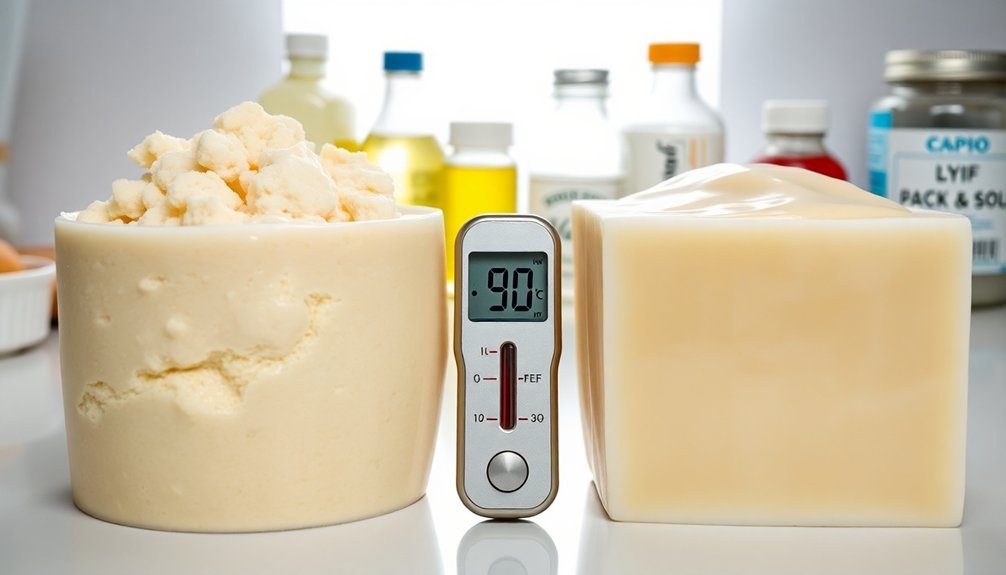
Although soap making can be rewarding, you'll occasionally encounter challenges like false trace, where your soap batter appears to thicken properly but hasn't actually reached true saponification. This premature thickening creates an illusion of emulsification while actually being incomplete.
False trace typically occurs when working in colder temperatures, where chilled lye causes hard oils and butters to solidify prematurely. You'll notice a grainy texture rather than the smooth consistency of a genuine thick trace.
Temperature management is essential—keep your oils and lye within 10 degrees of each other, ideally between 100-130°F.
Certain fragrance oils, especially those containing alcohol, can accelerate false trace during mixing. To distinguish it from true saponification, look for solid chunks in your soap batter—false trace appears lumpy, while proper emulsification remains uniformly smooth.
Identifying the Warning Signs of False Trace
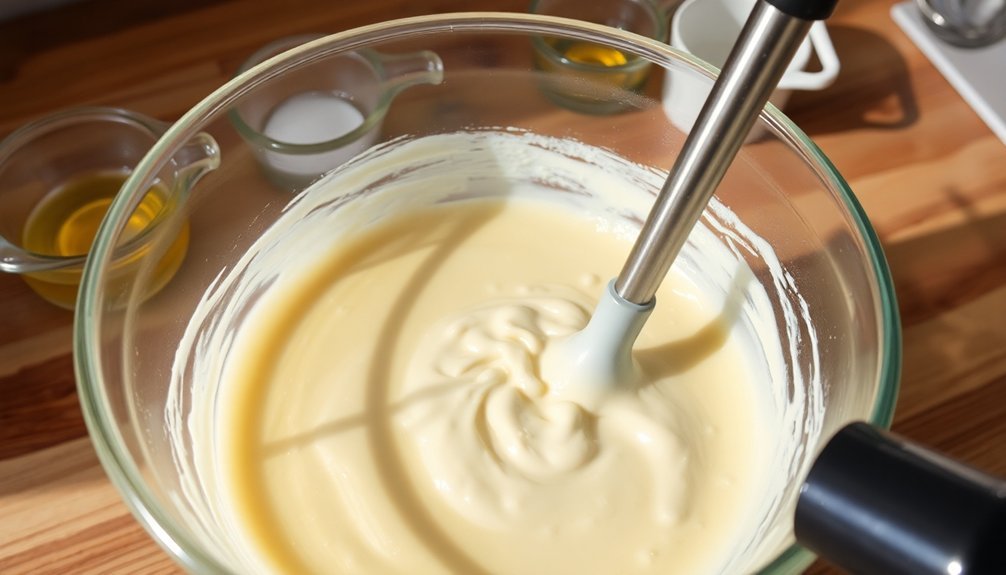
When you're blending your soap ingredients, recognizing false trace early can save your batch from potential failure.
Watch for a grainy texture that thickens unusually fast, forming solid chunks rather than a smooth, pudding-like consistency. If you notice lumps or separation in your mixture, it's a clear indicator that full emulsification hasn't occurred.
Temperature is a critical factor—chilled lye or cold oils can cause hard oils to solidify prematurely. Be especially vigilant when using fragrance oils containing alcohol, as these can accelerate trace deceptively.
After pouring into molds, inspect for pockets of liquid or separation, which signal incomplete emulsification.
Catching these warning signs early prevents disappointing results during curing and helps you take immediate corrective action before your soap sets improperly.
Temperature Control: The Key to Preventing False Trace
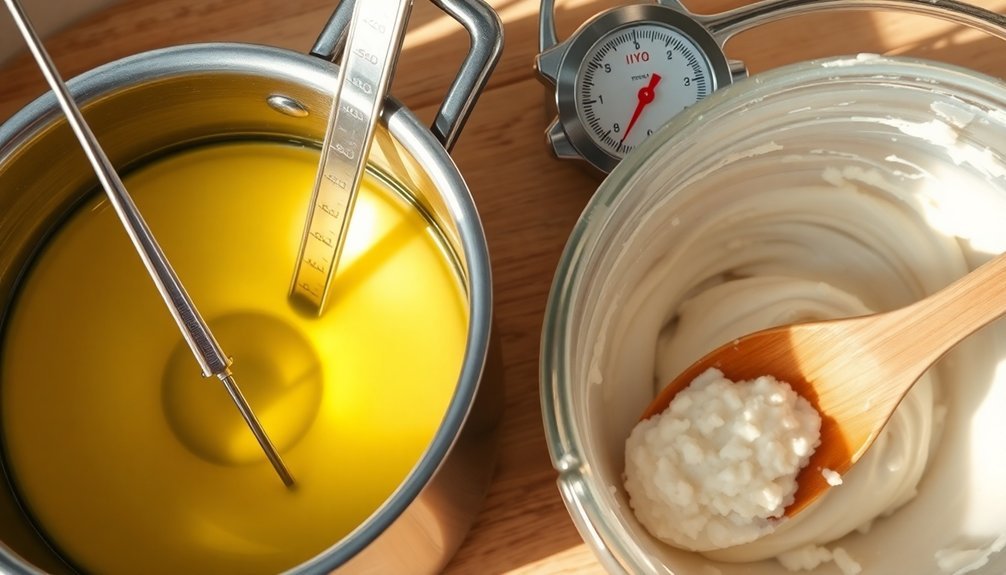
Monitoring your oil and lye temperatures is critical to preventing false trace, with experts recommending keeping them within 10 degrees of each other.
You'll want to maintain temperatures between 100-130°F when working with hard oils like cocoa butter to guarantee they don't prematurely solidify during mixing.
If you notice signs of false trace forming, placing your soap mixture in a warm water bath can help re-emulsify the ingredients and save your batch.
Temperature Danger Zones
Temperature control serves as the foundation for successful soap making, particularly when combating false trace. When your soap components fall into temperature danger zones, you'll likely encounter problems with emulsification. Keep your soaping temperatures between 100-130°F to prevent hard oils from solidifying prematurely.
| Temperature | Oil Behavior | Result |
|---|---|---|
| Below 100°F | Hard oils solidify | False trace occurs |
| 100-130°F | Ideal emulsification | Smooth, proper trace |
| Above 130°F | Accelerated reaction | Soap seizes too quickly |
Remember that lye and oils should remain within 10 degrees of each other. If you've chilled your lye water too much, you're inviting solidification of coconut oil or cocoa butter, resulting in a grainy mixture that mimics trace. High temperatures, conversely, can rush the process, especially in recipes with significant hard oil content.
Monitoring Oil Phases
The three phases of your oils directly impact whether you'll achieve proper trace or fall victim to false trace. When combining lye and oils in the soap making process, maintaining temperatures between 100-130°F guarantees proper emulsification instead of premature hardening.
Keep the temperature difference between your lye solution and oils within 10°F to prevent hard oils from solidifying too quickly.
Remember that different oils have varying melting points—coconut oil solidifies at 76°F while cocoa butter hardens at 100°F. If your mixture begins thickening unexpectedly, place it in a gentle water bath to maintain workability.
During stick blending, use short pulses rather than continuous blending to better identify true trace from false trace. This pulsing technique gives you greater control over the emulsification process and helps you recognize when your soap is truly emulsified versus simply thickened by temperature issues.
Rescuing a Batch With False Trace
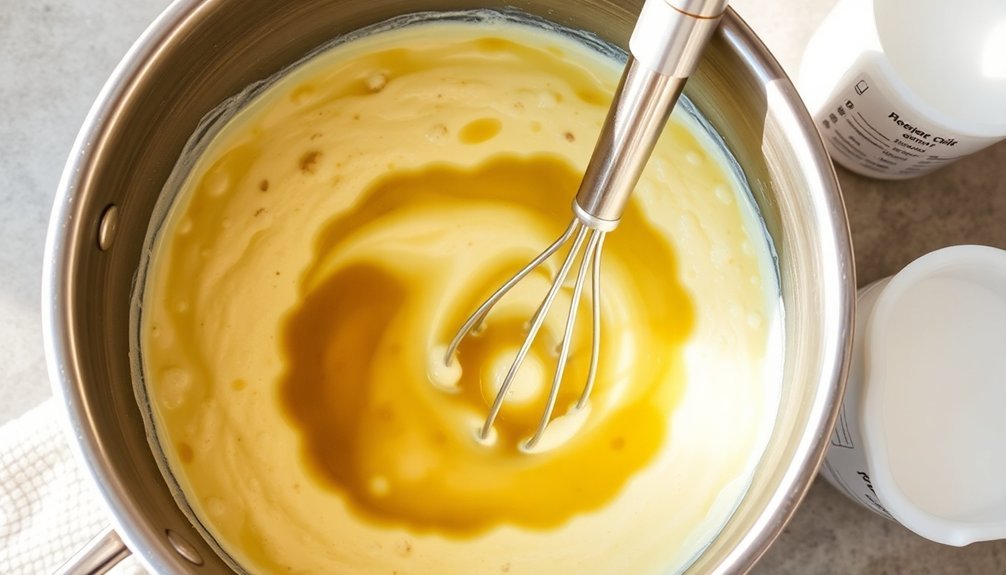
When you've encountered false trace in your soap-making process, don't panic—the batch can still be saved with quick action.
Immediately stop stick blending and place your mixing bowl in a water bath to gently heat and melt solidified oils, promoting proper emulsification.
If your soap batch appears grainy, continue stick blending in short pulses while monitoring for lumps.
Remember that maintaining oils and lye temperatures within 10 degrees of each other prevents premature thickening that causes false trace.
For stubborn cases, try grating the partially solidified soap and reprocessing it with added olive oil or aloe vera to rehydrate and improve texture.
After reworking your batch, always perform a zap test to ascertain complete saponification before using.
With these techniques, you'll rescue your soap and achieve the smooth consistency you desire.
Hard Oils vs. Soft Oils: Impact on Trace Development
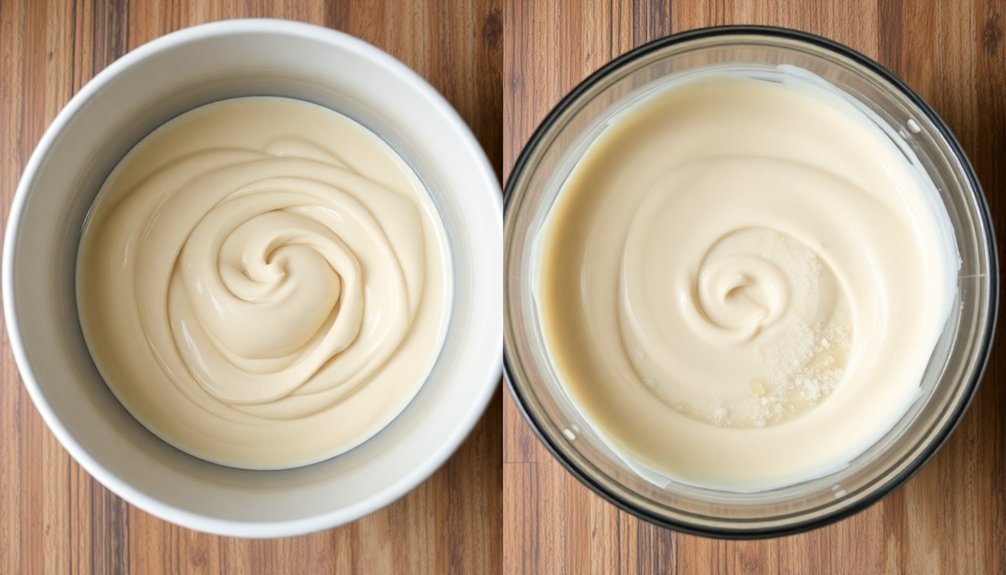
Understanding the difference between hard and soft oils is essential for preventing false trace in your soap recipes.
Hard oils like coconut oil and cocoa butter have higher melting points, causing them to solidify quickly at lower temperatures during the saponification process. This rapid solidification can be mistaken for true trace development.
In contrast, soft oils such as olive oil and canola oil remain liquid longer due to their lower melting points, giving you more working time.
When formulating recipes, balance is key—too many hard oils can accelerate trace and potentially create a grainy texture in your finished soap.
To manage this balance effectively, maintain your lye and oil temperatures within 10 degrees of each other.
Recipes with higher percentages of soft oils will generally provide more control and help you avoid the pitfalls of false trace.
The Role of Fragrance Oils in Accelerating Trace
Fragrance oils represent a double-edged sword in soapmaking, as they contribute delightful scents while potentially disrupting your carefully planned trace development. Their chemical composition, especially those containing alcohol bases, can dramatically accelerate trace and cause unexpected thickening issues during your soap-making process.
Different fragrances behave uniquely—floral scents typically speed up trace, while citrus oils may slow it down. To maintain control, add your fragrance oils after achieving a light trace, which extends your working time before the batter becomes too thick to manipulate.
Always test new fragrances in small batches first to understand how they'll behave in your recipe. Monitor temperature carefully, as warmer mixtures combined with trace-accelerating fragrances can quickly turn your fluid batter into an unworkable mass before you're ready.
Testing Methods to Confirm True Trace
Just as fragrances can deceive your soap batter, false trace can mislead even experienced soapmakers into thinking their mixture has properly emulsified.
To avoid this common pitfall, employ these reliable testing methods:
- Consistency Check – True trace resembles a smooth, emulsified batter without grainy texture; false trace appears lumpy with potential separation.
- Spoon Test – Drizzle the mixture over itself; true trace leaves a distinct trail while false trace disappears.
- Drop Test – Let a small amount fall from height; true trace holds its shape rather than sinking back.
- Temperature Control – Monitor your ingredients' temperature, keeping them within 10 degrees of each other to prevent false trace issues.
Trust your eyes and these tests rather than relying solely on time or appearance to guarantee soap-making success.
Adjusting Your Recipe to Minimize False Trace Risk
While crafting the perfect soap formula requires balancing many variables, carefully adjusting your recipe's composition can dramatically reduce false trace problems.
Maintain both lye water and oils between 100-130°F to guarantee ingredients become fully emulsified, especially when using components that are solid at room temperature.
Increase your percentage of liquid oils like olive or canola to extend working time and prevent premature thickening.
Pre-melt all hard oils and butters completely before combining with other ingredients.
Keep beeswax below 9% in your formula, as it can accelerate trace and compromise lather quality.
Before committing to large batches, test potentially problematic fragrance oils in a small batch first.
This allows you to adjust your recipe intelligently when you encounter ingredients that cause rapid acceleration.
Frequently Asked Questions
What Causes False Traces in Soap Making?
False trace occurs when your cold lye meets hard oils, causing premature solidification rather than true emulsification. You'll notice a thick, grainy mixture forming. Temperature discrepancies and certain fragrance oils can also trigger this issue.
What Does a False Trace Look Like in Soap?
A false trace looks thick but grainy, with pudding-like consistency and solid chunks. You'll notice it's not smooth, has uneven texture with possible lumps, and may have pockets of liquid throughout the mixture.
How Do You Slow Down Trace in Soap?
You'll slow down trace by using high-liquid-fat oils, soaping at cooler temperatures (70-80°F), choosing trace-friendly essential oils, adding clays or yogurt, and pulse blending rather than continuous blending while making your soap.
Can I Remelt Soap to Fix It?
Yes, you can remelt soap to fix it. Just grate it into small pieces, heat gently, and add a little liquid if needed. Use a stick blender to re-emulsify, but don't overheat or remelt excessively.
In Summary
Don't be discouraged if you've experienced false trace in your soap making. With proper temperature control, careful oil selection, and the testing methods we've covered, you'll recognize and prevent this common issue. Remember to adjust your recipes if needed, and be cautious with fragrance oils that accelerate trace. Soon, you'll be creating perfect batches with the confidence of a seasoned soap maker.
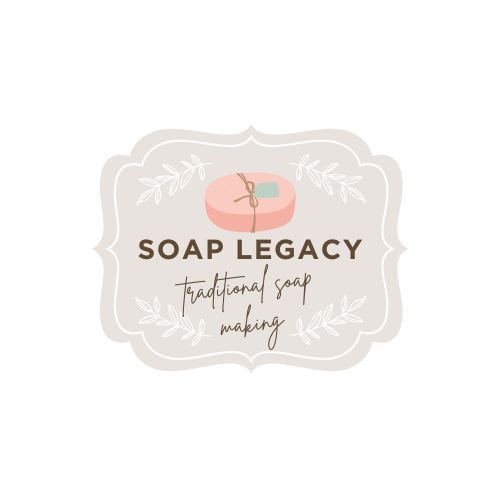
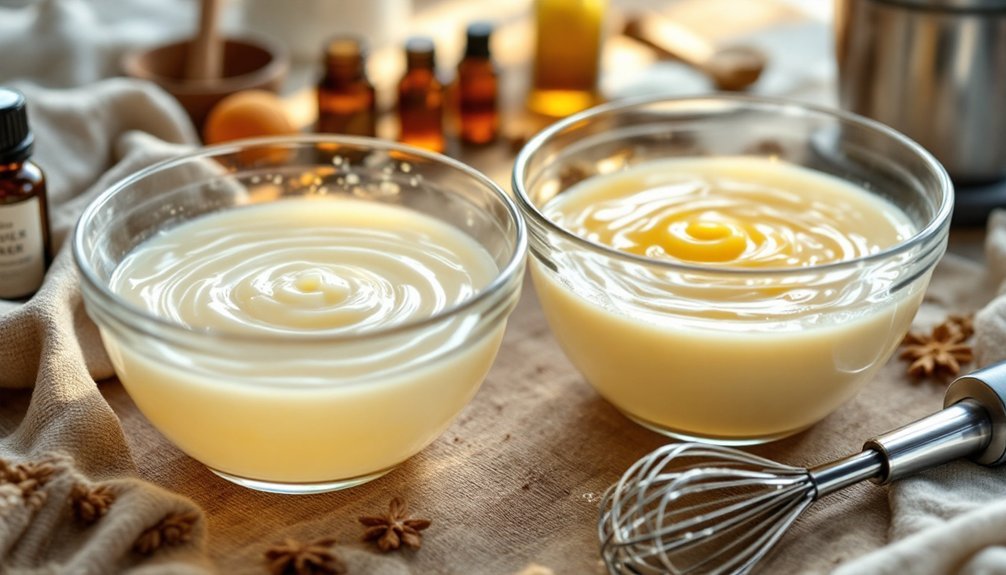
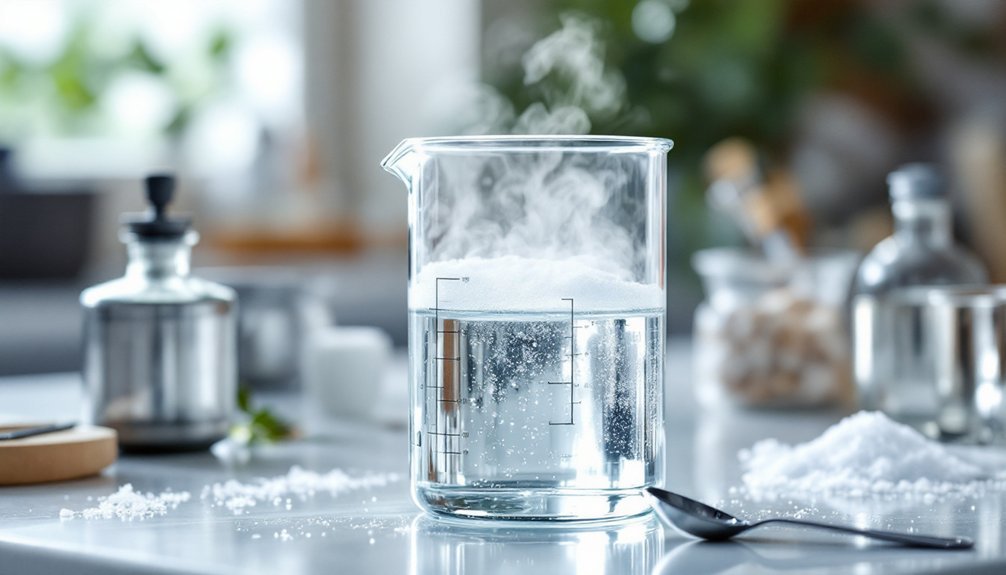
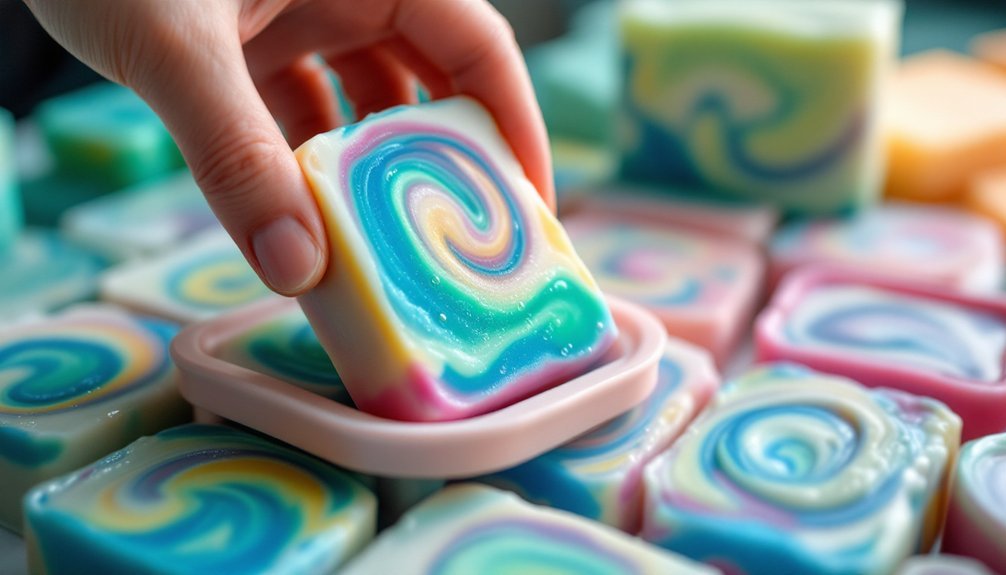

Leave a Reply